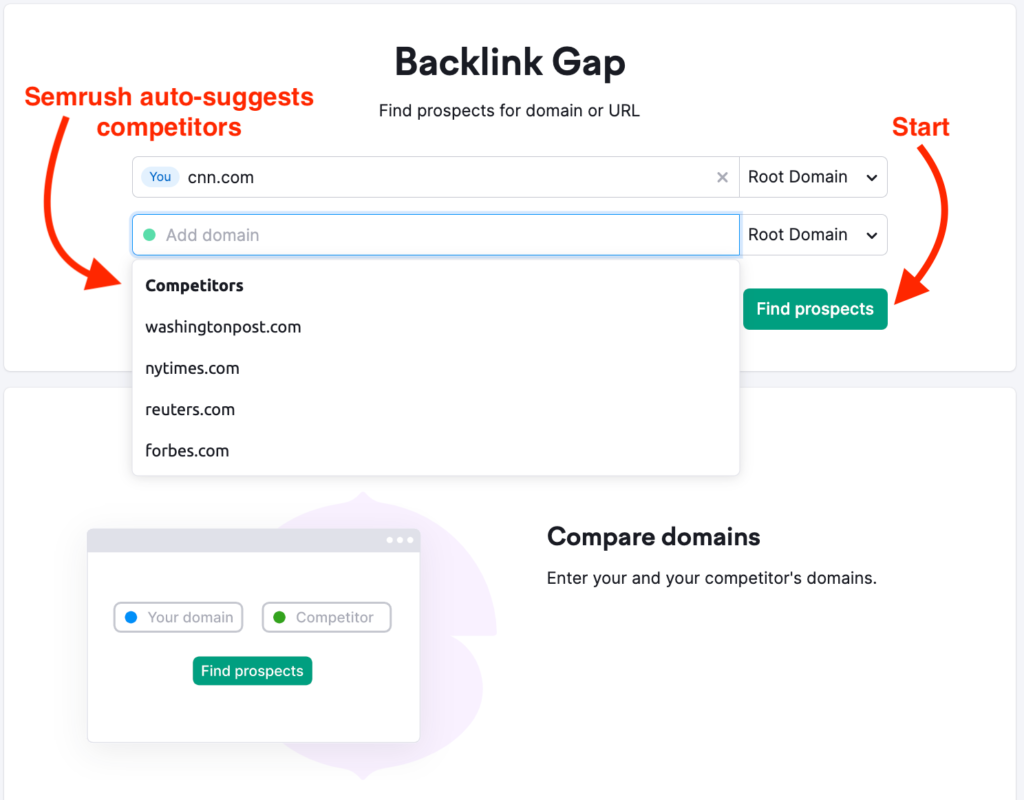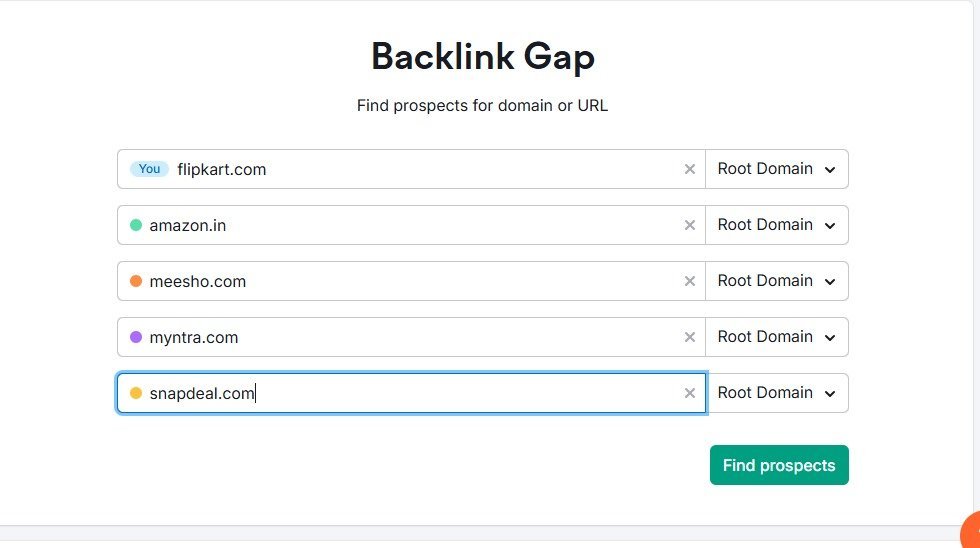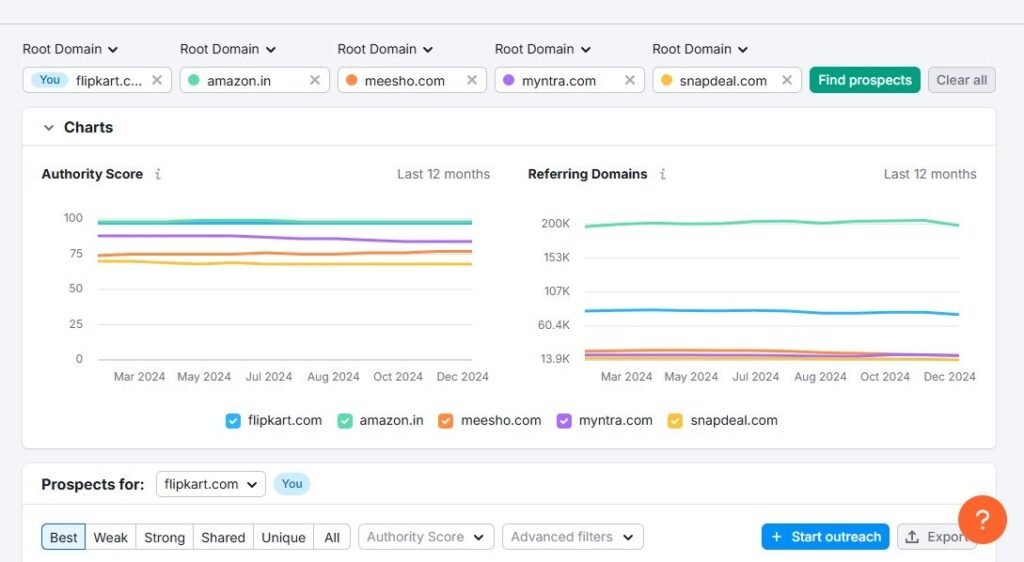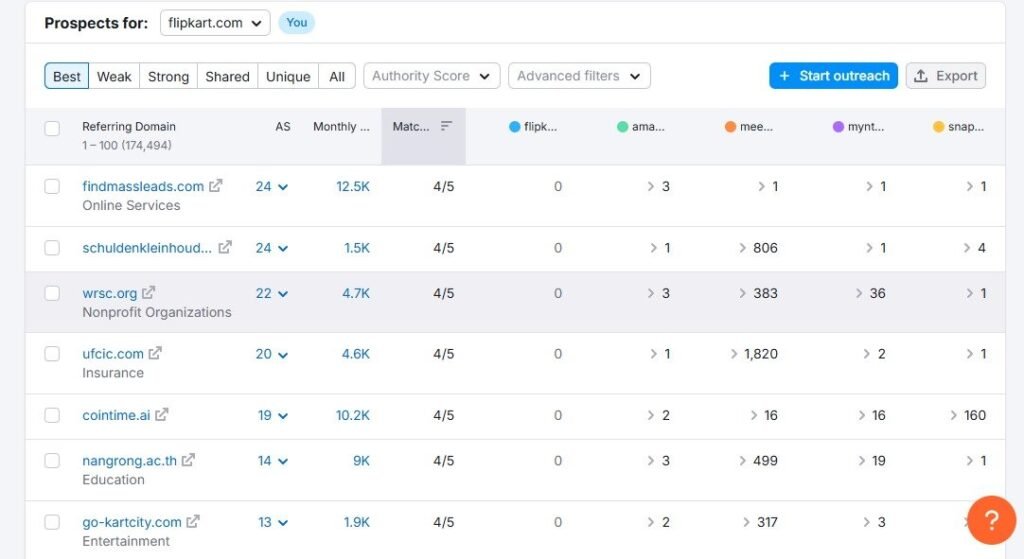Imagine you are running a race, but you cannot see where you are going or who else is running with you. You are running blindfolded.
In the fiercely competitive SEO world, this is kind of what it feels like if you don’t know what your competitors are doing to outrank you.
Backlinks remain one of Google’s top ranking signals and according to a study by Backlinko, the top-ranking pages on Google have 3.8 times more backlinks than that of the lower-ranking ones
So the point is, whether you are just getting started off with a backlink campaign or already doing robust backlinking for your website. Knowing where your competitors are getting their backlinks from and who is linking to their website is an activity that you should do – period.
This is why SEO specialists carry out a backlink gap analysis. You can call it competitor backlink analysis as well. Backlink gap analysis helps you see the difference between your competition and you by revealing the backlinks they have acquired that you have not.
In this guide, we will dive deep into how you can perform backlink gap analysis for your website. We will:
- Explore why backlink gap analysis is crucial for your SEO success
- Introduce some powerful tools to help you execute the process
- And walk you through the step-by-step process of conducting a gap analysis using one SEO tool.
- And we will also list some actions to perform after you have done your analysis.
Let’s get started!
Why Should You Perform Backlink Gap Analysis?
Backlink gap analysis is not about copying but about learning the link gaps and closing them. When you see a competitor earning a link from a highly authoritative website, it should inspire you to:
1. Improve Search Engine Rankings
Gap analysis helps you figure out where your competitors are getting all the attention and how you can get in on the action. Having access to insights about which websites are linking to them places you in a better place.
How?
With the information, you can figure out a strategy that helps you build relationships with those website owners, earn those valuable links, and improve your site’s visibility and rankings.
2. Discover Strategic Link-Building Opportunities:
Competitor backlink profile analysis helps you know the secret to getting your website noticed by search engines. It shows you exactly which websites link to your competitors.
Instead of blindly trying to get any link, gap analysis data helps you focus on your strategic efforts to build relationships with the right websites – the ones that are already established and influential in your industry.
3. Enhance Competitive Positioning
With backlink gap analysis, you can understand your competition better and secure a stronger place in the SERPs. Analyzing and acquiring those links is the only way to close those link gaps and surpass your competitors.
This data-driven approach helps you focus your efforts on the opportunities that matter the most. Then, it would become easier to increase your domain authority.
Now that you understand the value backlink gap analysis can bring to the table, it’s time to put it into action.
Tools to Consider for Competitor Backlink Gap Analysis
So, how exactly do you go about uncovering these hidden backlinks that your competitors are enjoying?
Fortunately, there are a great many powerful backlink analysis tools available to streamline the process, including:
1. SEMRush is an all-in-one SEO toolkit that helps you find your competitors’ backlinks and analyze their overall online visibility, identify keyword opportunities, and track your own progress.

2. Ahrefs is good for identifying and analyzing backlinks, plus, it allows you to compare your backlink profile with your competitors’, uncover broken links, and identify potential link-building opportunities.

3. You can use Majestic for understanding the quality and authority of your backlinks. It offers you a deep dive into your website’s backlink profile, including trust flow and citation flow metrics.

4. With Screaming Frog, you can analyze internal and external links on your site, which can indirectly inform your backlink gap analysis.

5. SpyFu provides insights into your competitors’ paid and organic search performance, including their top-performing keywords and backlink profiles.

In the next section, we will discuss some easy steps to perform this analysis yourself.
We will be using the SEMRush Backlink Gap tool.
Let’s dive right in.
How to do Backlink Gap Analysis – A Step-by-Step Guide Using SEMrush
Before jumping right into the analysis process, I would like to point out an important factor to consider before you start the process.
That is identifying who your competitors are.
If we assume you already have a list of them, you can just scroll down and start from step 2. But if you have not identified your competitors yet, this is the first step you need to do before you start the gap analysis.
You can easily identify your competitors by doing a Google search. Alternatively, you can stay on SEMrush and use the tool to do the job for you. Start with step 1, and keep following.
Step 1: Know Your Competitors
Not just any website will do—we’re talking about the ones that truly matter, the websites dominating the search results for your target keywords. SEMrush provides several tools to help you identify these competitors.
Start with the Domain Overview tool in SEMrush. Simply enter your website, and it will reveal key information about the keywords driving traffic to your site. Scroll down to the Top Organic Competitors section to see which websites are competing for those same coveted rankings.
You can also use the Organic Traffic Insights tool to analyze the keywords that bring visitors to your site. This tool combines data from Google Analytics, Google Search Console, and SEMrush to help you understand which search terms are most relevant to your audience.
Majorly there are two types of competitors you will need to keep an eye out for:
A. Domain-Level Competitors:
These are your direct competitors. They are trying to outrank you across a wide range of keywords within your industry.
B. Page-Level Competitors:
These websites are more specific, targeting specific pages or topics on your site. For example, if you have a blog post about “The Best SEO Tools,” your page-level competitors would be other websites with blog posts specifically about that topic.
Once you have identified these two types of competitors, jot down their domain names. We will be scrutinizing these competitors closely.
This list will form the foundation for your backlink gap analysis. It will help you pinpoint the specific areas where your competitors have a competitive advantage in terms of backlinks.
Step 2: Access the Backlink Gap Tool – Using SEMRush
Log in to your SEMrush account and navigate to the Backlink Gap tool, which is under the “Link Building” section.
Step 3: Enter Your Domain
Enter your domain in the search bar.

Image Source: SEMRush
Step 4: Add Competitor Domains
In the other input fields, add up to four competitor domains. These competitors can be subdomains, root domains, or URLs.

Step 5: Analyze Backlink Profiles and Find Backlink Gaps
Once you have entered your and your competitors’ domains, click Find Prospects. The tool will generate a graph and a comparison table between you and your competitors; backlink profiles:
- The graph will tell you which competitor is generating the most number of backlinks.

- The comparison table will show the below data:

Authority Score
This score reflects the overall quality and authority of a site.
Referring Domains
You can easily adjust the list of referring domains compared to your own website using the Prospects for Domain filter. Simply click on the dropdown menu located above the table to make your selections. Plus, you can refine your list of Prospects through the Authority Score and Advanced filters.
Monthly Visits
It’s an estimate of the total number of visits to a particular website over a month.
Matches
This gives you an idea of the number of analyzed domains that this referring domain is linked to.
To see new, lost, or followed links from a specific competitor, click on the “view” dropdown in their column to expand the row, and there you will get more details.
Step 6: Filter and Refine Results
Filter by Matches:
In the Matches column, you will see the total number of referring domains that link to your competitors. All you need is to use the up or down sorting arrow in your competitor’s column.
If multiple competitors have earned a link from the same website, it’s a strong signal that this website is open to linking to businesses within your industry.
Filter by Best, Weak, Strong, Shared, and Unique Domains:
- Best Domains: These websites are linking to all your competitors (but not you).
- Weak Domains: These websites are linking to you less than your competitors.
- Strong Domains: These websites are only linking to you.
- Shared Domains: These websites are linking to both you and your competitors.
- Unique Domains: These are linking to only one specific domain.
Step 7: Export Data
Now you want to use the backlink gap analysis data later to start a link-building campaign, export it to Excel or CSV.
Step 8: Identify Link-Building Opportunities
Check the Weak part, i.e., links your competitors have but you don’t. Only consider high-authority domains linking to multiple competitors.
Now that we have discussed the step-by-step process of using SEMrush for backlink gap analysis, it’s time to put the insights we have gathered to use.
3 Actions to Take with the Backlink Gap Analysis Report (The Next Steps)
The insights from the backlink gap analysis provide actionable data you can use to create a strategy to close the gap and improve your site’s authority.
So, let’s explore the next steps to make the most of your Backlink Gap Analysis report.
1. Qualify Prospects:
Make sure to evaluate the quality of potential linking domains. Consider factors like authority score, spam score, and relevance to your niche.
2. Plan Outreach:
Once you have exported the report, jot down the list of potential backlinks you want to target.
3. Monitor Progress:
Monitor your campaign progress and frequently keep running this analysis on your competitors’ backlinks to see what’s working for them and adjust your own strategy accordingly.
Final Thoughts
It makes sense that you want to know what gives your competitors an edge in search. Backlink gap analysis reveals the missing pieces of your SEO puzzle.
Getting a sneak peek into the backlinks of your competitors can help boost your website’s authority and credibility in the eyes of search engines. When you know where your competitors are getting linked from, you can secure the same links to enhance your trust signal and improve your search rankings.
Use the insights you get from your backlink gap analysis using SEMrush so that it can help refine your link-building strategy. With consistent effort and a data-driven approach, you can surely get yourself to the top of the SERPs.
